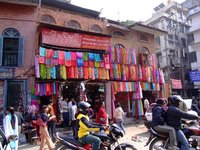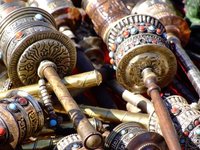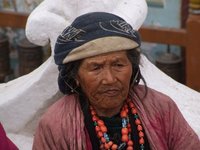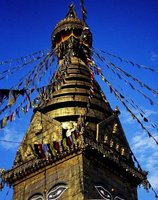Kathmandu
Travel Guide Asia Nepal Kathmandu
Introduction
Kathmandu is the capital and largest city in Nepal. Set on an elevation of 1,337 metres above sea level, with a population of over around 800,000, Kathmandu is the the most modern city in the country - which isn't necessarily saying much. In Kathmandu, modern development encounters a laid-back, devoutly Hindu society.
Kathmandu has the only international hub airport in Nepal, so unless visitors cross overland this is where your time in Nepal will begin.
Neighbourhoods
Thamel, in downtown Kathmandu, has achieved almost legendary status as a backpacker's bliss. It is a colourful jumble of craft shops, boutique cafes, tuk tuks, trekking gear, and rainbow prayer flags. The roads are narrow, squeezing every walk of life together, but, unlike many other Asian cities, there is no sense of urgency or claustrophobia. The hippie trail's anything-goes attitude still lingers in the tiny alleys, while Tibetan chanting hangs in the air. If you do need a break from ground level Thamel, just find a restaurant and head upstairs, where you'll find yourself in a maze of laid back rooftop gardens stretching across the area, set against bright blue skies and snow capped mountains. These are brilliant spots to get out your guidebook, order a (surprisingly good) coffee and grab a slice of homemade cake. At night, Thamel is a twinkling mass of coloured lights, paper lanterns and neon restaurant signs. You'll never be short of ideas about where to eat. Every couple of paces, you'll find somewhere famed for its delicious dishes and cosy ambience. It really is, quite possibly, the very best place in the world for guilt-free gluttony. After all, you can trek all of it off the next day.
Sights and Activities

Kathmandu market
© TLWH
Thamel
The heart of of "tourist" Kathmandu. A thriving labyrinth of narrow lanes and streets that no map can truly distinguish. Jam packed with hotels, hostels and guesthouses, a tout is never far away. Yet never so aggressive as to be annoying. Fake trekking stores offer fakes, copies of fakes, and fake copies of trekking gear. Some good, some not so good, and some to avoid so be careful. There are tour agencies, bookstores and restaurants everywhere you look so there's no chance of becoming bored. Though longer term back packers tend to find it's touristy ways a little much after a few weeks.
- Z-Street - There were many hippies in the 1970s who found their way to Kathmandu and never left. Many of them opened businesses in this area. Several of Kathmandu's funky little backstreet cafes can be contributed to their presence and legacy.
Durbar Square
This UNESCO World Heritage Site is the heart of the city. This a actually not one square, but three squares linked together. The area is packed with temples and other monuments, but its two most famous features are Hanuman Dhoka, the old royal palace, and Kasthamandap, the wooden house from which Kathmandu takes its name. The Taleju Temple which is overlooking the square is maybe the most beautiful, but is closed for the public
Durbar Square is one of the seven groups of monuments and buildings which display the full range of historic and artistic achievements for which the Kathmandu Valley is world famous. It is of extreme importance regarding the cultural heritage in the country. The seven groups of monuments and buildings, apart from Durbar Square, include Patan and Bhaktapur, the Buddhist stupas of Swayambhu and Bauddhanath and the Hindu temples of Pashupati and Changu Narayan.
Kumari Chowk is the closed off small courtyard where if you are very lucky you might get a glimpse of the living Goddess (the Kumari). She is transported through the city during the Indra Jatra Festival on a chariot. A part of the chariot can be seen from the higher steps of the Trailokaya Mohan Nayaran Temple.
To gain entrance to Durbar Square a fee needs to be paid. You will need to show your ticket also when you happen to be just passing the square on one of your walks. The ticket is only valid on the day it is stamped, if you need a longer duration ticket you can get these at the ticket office. Be aware that for tickets longer than 3 days, you will need to bring you passport and 2 passport-sized photo's.
Swayambhunath
Swayambhunath, or The Monkey Temple, is as its touristy name suggests a stupa that's overrun by primates. It's a good 15 minutes of steep climping to get to the stop, but worth it as this famous stupa is a spectacle to behold. Watch your valuables for primate hands dipping into it. There's a secret way into the temple around the back as well. But best to take the steps the first time you head up.
Pashupatinath
The Varanasi of Nepal. Burning Ghats, temples and Sadus abound in this religious and sacred place. Beware of Shiva's birthday though, it's the one day in the year Hashish is legal, so the crowds are huge!
Tibetan Monasteries

Prayer Wheels from Nepal
© TLWH
Kathmandu is surrounded my Tibetan monasteries. Visiting one is well worth the usual long hike you need to endure. Most are also open to volunteers.
New Road
It's not a great deal to see, but the place to come if you need to stock up on memory cards, batteries or get your camera equipment sorted out. Ignore Thamel's tourist prices, and go to the genuine dealers here.
Events and Festivals
Non-Religious Festivals
- Jazz Festival has been held every March since 2002. This event has been dubbed "Jazzmandu". It features many high-calibre musicians from around the world. For more information on this years event visit them at their website.
Religious festivals
There are also many religious events in Kathmandu and the rest of Nepal throughout the year.
They include:
- Losar in January/February is the Tibetan New Year. There are processions and ceremonies all over. Most locals will tell you where their favourite one is.
- Shivaratri in February/March is a Hindu celebration in honor of Lord Shiva. There are celebrations at Shiva temples all over. Some are bigger than others.
- Holi in February/March is a celebration of the power of good's triumphs over evil. People go nuts in the streets splashing water over everyone, and then dusting them with colored powders. Tourists watch out; they seem to get it worse. If you have a chance to go though, don't miss it.
- Buddha - Jayanti May/June is Buddhas Birthday. A pretty big deal.
- Indra Jatra in September is a Hindu celebration of Indra, their god of war and the elements. Chariot parades, masked dancers and animal sacrifices.
- Dasain in September/October is a very long celebration of Durgas victory over a Demon named Mahisasura. It lasts about two weeks.
- Tihar in October/November is the Nepali festival of lights. They decorate animals with flowers and put lights all over their houses.
Weather
Most people plan on some trekking during their trip to Nepal and base themselves in Kathmandu first. The best times to do this are October/November and March/April. During these periods, you'll hopefully see blue crisp skies, brilliant sunshine and very chilly nights. Average daytime temperatures around these times are mostly between 20 °C and 25 °C, while nights are mostly around or slightly above 10 °C. In spring (March/April) the bougainvillea blooms, so the lower sections of your treks will be even more colourful. The monsoon arrives in the height of summer (late June - October), and there tends to be rain almost every day. However, this may well be a short heavy shower rather than constant downpour, so please don't be discouraged from visiting Kathmandu if summer is your only window of opportunity. Many treks are still possible over this period, but you'll need to watch your footing more carefully (or bring some hiking poles) and watch out for leeches - they really are wily little buggers! Temperatures during these summer months are mostly around 26 °C to 28 °C during the day and around 16 °C to 20 °C. Winters are coldest with 16 °C to 18 °C during the day and 4 °C or 5 °C at night.
Getting There
By Plane
Tribhuvan International Airport (KTM), about 6 kilometres from the centre of Kathmandu is the only international airport in Nepal. Nepal Airlines, the national airline, serves flights to Hong Kong, Osaka, Shanghai Pudong International Airport, Bangkok, Kuala Lumpur, Delhi and Dubai. Do not expect western standards and major delays sometimes. The room per seat maybe less that you are used to. People over 1.85 metres (over 6 feet) tall will definitely notice the lack of leg room, but overall they aren't that bad.
There are about two dozen airlines, with other destinations being served, like Amsterdam, Bahrain, Chengdu, Lhasa, Dhaka, Guangzhou, Paro (Bhutan), Abu Dhabi, Kolkata, Varanasi, Seoul, Muscat, Islamabad, Karachi and Singapore.
There are quite a few other small airlines serving domestic flights to places like Jumla, Surkhet, Nepalgunj, Pokhara, Biratnagar and Bharatpur.
By Train

Nepalese Lady
© TLWH
No train links exist to and from Kathmandu.
By Car or Motorbike
It's possible to rent a car and driver for a day, or for several days. Prices vary and it is best to negotiate for everything including food and fuel. Renting a motorcycle is another option. Rates start at around 400 rupees per day. Several tour agencies will hire a bike for you. It's best to carry a mobile phone with sim card in case of break downs.
By Bus
From the Sunali border it's about 9 hours to Kathmandu or Pokhara, depending on traffic and road conditions. Local buses and tourist buses leave frequently. GreenLine bus is the premier tourist class bus service with frequent Pokhara to Kathmandu links. They serve a large buffet lunch and often state they are an hour faster than local tourist buses. They cost about US$17 for the trip. While a local tourist bus is a two thirds the price, but with no lunch. A local ordinary bus is half the price again. All buses take about the same time, but a local ordinary bus does take longer due to more stops.
Travel Agents
There are more travel agents in Kathmandu than you can possibly imagine. You will have no problem in finding them.
It's a lot cheaper booking in person than over the internet. A tour can be arranged for the next day with no problems, weather permitting. A good example, Travel Link Services, is located at G.P.O. Box 9057 Chhetrapati, Kathmandu, Phone: 977-1- 42 63 618, 42 64 969, Email: [email protected]. It is a travel agent that can help arrange trips to Lhasa and other places in Tibet.
Getting Around
By Car
It's advisable to get a driver with a car to explore Kathmandu. Some roads are not well maintained and you might easily get lost. Renting a car yourself is not advised.
By Public Transport
Mini vans can dart you out to the suburbs with frequency. They are cheap, overcrowded and leave often.
By Foot
Nearly everywhere in Kathmandu is accessible by foot. Thamel is best avoided if you are looking for a cultural day out, as it's tout ridden. But once past this area it's easy to plan out a day trip. Maps are needed if you plan on not getting too lost. When walking around Kathmandu, here's a hint: All those guys that sidle up to you and ask "Asheesh?" are not mistaking you for a local celebrity. They are trying to sell you something.
By Bike
Renting a motorcycle is possible to go between places like Patan Kathmandu, but for inner city traveling are best avoided due to the heavy traffic build up.
By Rickshaw
Kathmandu is fairly small so one of the easiest and quickest ways to get about is to flag down a rickshaw. Although if you are planning on staying fairly central, walking is the best option.
Eat
Nepalese food is plentiful and easily obtainable here.
- Dhal Bhat - the most stable of Nepalese foods. A platter of rice, soup, green leaf salad, popa dum. Meat is also served with it. The great thing about this food, is that seconds are free, as are thirds, etc. It's an all you can eat meal.
- Momos - steamed dumplings filled with vegetables, meat, or cheese (usually yak). They are very cheap when found in local eateries, out side of that the tourist prices are inflated.
- Chinese food - stir fired noodles are available in most local places at very low prices.
- Buffalo steak - tougher than cow, it's available in most places.
- Beef steak - imported from Bangladesh, it's cooked to near perfection in such steak houses as Everest, and RumDoodle.
- Pancakes - Nepal's mainstay for trekking or sight seeing tourists.
Western Food
Devoid of fast food, Kathmandu hosts a myriad of international restaurants. Italian pastas and pizzas are available just about everywhere. Chinese food is listed on nearly every menu. Indian cuisine is spicy and prepared well. While the Mexican offerings are a little non-Mexican.
Make sure all your meat is cooked. And if the place is questionable, eat cooked vegetables too.
Drink
Kathmandu is chock a block full of places to drink. Famous places such as Rum Doodle along with Tom and Jerry's offer everything from cheap beer, to cocktails galore. Many staying open so long as there are customers.
It's worth trying the warm fermented Tibetan beer at least once. Available in many of the local Tibetan eateries.
Check out the Celtic-Manang bar in Thamel. Great music - chilled atmosphere - dart board and friendly staff. The owner Mary from cork is a wealth of useful information and always up for a chat. Be sure to check out the menu if your missing a taste of home as the bangers and mash or shepherds' pie really hit the spot.
Sleep
For a detailed breakdown, have a look at our article on the best areas to stay in Kathmandu
Budget
There are many many cheap budget hotels in Kathmandu. Most offering rooms from $5 upwards, though for longer periods of time guests discounts are available.
Thamel can get noisy so one might think about walking for 5 minutes out of the tourist hotspot to Pakanajol. Here there are a host of homely, clean and secure guest houses such as the Kathmandu Garden House, Pakanajol Tel 977 - 1 -4381239 where a friendly French Nepalese couple will look after you very well.
Upscale
Work
Kathmandu, like most of Nepal, is among the poorer areas in Asia. Work for tourists is scarce. Yet it is there is the form of volunteering. There are plenty of online pay to volunteer NGOs out there. But once in the city you will find the streets full of local organizations seeking help. Some offering accommodation and local food in return.
Keep Connected
Internet
Internet connectivity is increasing rapidly, and obviously its availability is most widespread in Kathmandu (especially in Thamel and around the Boudha Stupa in Boudhanath) or Pokhara. In those two cities, most hotels and lodges will have free Internet connection with Wi-Fi. So will many restaurants. More and more villages will have Internet available at some lodges, usually with Wi-Fi.
Phone
See also: International Telephone Calls
There are two main mobile operators in Nepal. Government run NTC (Nepal Telecom Company), and private Ncell (previously called Spice Mobile and Mero Mobile). Both operators allow tourists to buy SIM cards for about 200NRs in Kathmandu and most major towns. You will need to bring a passport photo, fill in a form and have your passport and visa page photocopied, expect too also have your finger prints taken. Try to buy the SIM card at a shop owned by the phone company as if you buy it from a corner shop it can take some time for the card to be activated, despite promises that it will be done in " a couple of hours".
Ncell SIM's - can be bought from many stores, but are best bought from official stores in Birgunj or Kathmandu. Micro SIMs can be cut for free if you need. Ncell offers two different SIM cards. The first is a usual SIM card that allows you to make calls to any phone (local calls are about NPR2.5/min), and you can also buy mobile data to use. The second is a data only SIM card, and can not be used for making or receiving calls. The advantage to the second sim being the rates for data are significantly cheaper than a call and data SIM.
Post
Nepal Post is the Postal Service Department of the Nepali Ministry of Information and Communications and the national post office of Nepal. Services are terribly slow, especially to international destinations. Post offices are generally open Sunday to Thursday from 10:00am to 5:00pm, and on Friday until 3:00pm, although some offices keep longer hours. For packages, it is recommend to use international courier services like DHL, TNT or UPS.
External Links
Accommodation in Kathmandu
We have a comprehensive list of accommodation in Kathmandu searchable right here on Travellerspoint.
Contributors
 Utrecht (31%)
Utrecht (31%)
from https://utrecht.travellerspoint.com TLWH (25%)
TLWH (25%)
from The Longest Way Home
as well as dr.pepper (12%), tleb (8%), Herr Bert (6%), Lavafalls (6%), Bryony (6%), trotalong (2%), marky27 (2%), hasbeen (2%), Sam I Am (2%), Hien (1%)
Kathmandu Travel Helpers

YuwrajRizal
Ask YuwrajRizal a question about KathmanduHow to go around the city.
Incase of Emergency
Find Travel Mates
This is version 77. Last edited at 1:13 on Feb 10, 25 by Peter. 30 articles link to this page.

Except where otherwise noted, content of this article is licensed under a Creative Commons Attribution-ShareAlike 3.0 License


